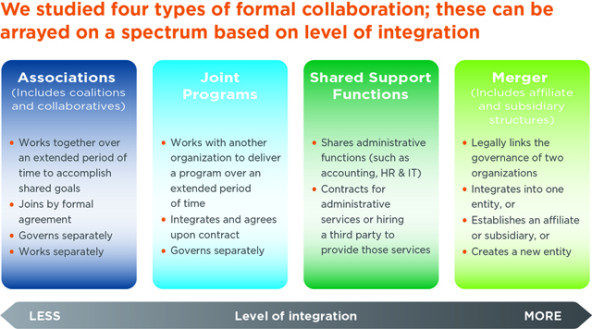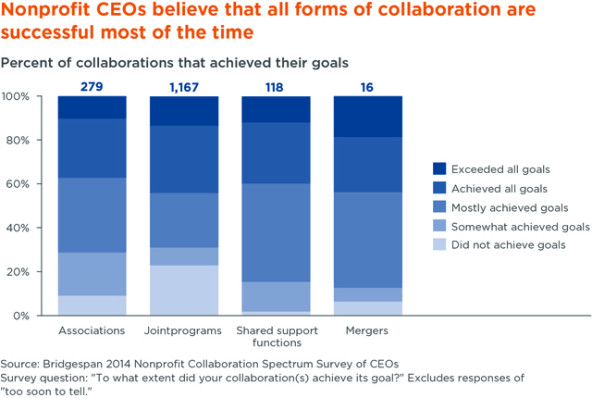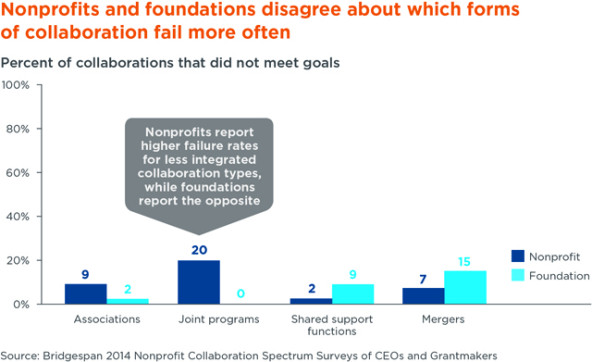Collaboration is a hot concept in the nonprofit world that finds itself at the heart of ideas like collective impact and transformative scale. The various forms of collaboration—associations, joint programs, shared support functions, and mergers—are all means to grow impact, be it through lowering costs, increasing the scope and scale of programs, or strengthening organizations’ ability to advocate for their cause.
And while a recent Bridgespan study published in SSIR found that the rate of nonprofit mergers in four states we surveyed was flat from 2007 to 2012, interviews with social sector leaders suggested significant increases in most other forms of collaboration.
In an effort to make sense of this supposed trend, even as sector leaders call for more of it, the Bridgespan Group, in collaboration with the Lodestar Foundation, conducted a survey of leaders from nonprofits and foundations across four common types of formal collaboration (see chart below). These collaborations were characterized by multiyear commitments and backed by written agreements that included charters, memorandums of understanding, and legal contracts. We then conducted follow-up interviews with a dozen CEO respondents and a half-dozen grantmakers. And we analyzed a database of 664 collaborations submitted for consideration for a prize.

Our research surprised us in four ways: the sheer volume of all types of collaborations; the high level of satisfaction with them by both nonprofit and philanthropic leaders; the strong desire for more collaborations at the most integrated end of the spectrum (shared support functions and mergers); and the places where nonprofits and foundations did not see eye-to-eye, creating significant barriers to achieving the full potential of collaborative endeavor.
High Rates of Collaboration
Are you enjoying this article? Read more like this, plus SSIR's full archive of content, when you subscribe.
The overwhelming majority of nonprofit and foundation CEOs responding to our survey had experience with one or more forms of collaboration, with 91 percent of CEOs already engaged in at least one of the four forms over the past three years, and 54 percent engaged in two or more. Meanwhile, 84 percent of funders said they had supported at least one collaboration.
Overwhelmingly, joint programming was the most prevalent form—a full 78 percent of nonprofits and 82 percent of foundations cited their involvement in joint programming, a pattern echoed in the Collaboration Prize database.

Our interviews found that most nonprofits increasingly see the less integrated forms of collaboration—associations and joint programming—as standard practice, but they believe that the more integrated forms offer the greatest new opportunity for increasing impact by streamlining costs, freeing up cash for programs, acquiring new capabilities, and expanding the reach of services.
A Remarkable Perception of Success
Given the challenges associated with collaboration, we expected to hear that many fell short. So, the most surprising finding was the overwhelming success that CEOs ascribed to the collaborations they participated in and that foundation officers ascribed to those they funded—70 percent or better in both cases.

With rates of satisfaction this high, one might suspect that leaders’ optimism biases the results, but even heavily discounted, such success rates are remarkable and worth paying attention to. SeaChange Capital Partners, which reviewed our data, found a similar success rate among more than 90 deals they funded.
Desire for More Collaboration
Furthermore, both nonprofit and philanthropic leaders expressed a great deal of appetite for participating in or supporting future collaborations. The executive director of a large, faith-based, multiservice program told us: “I do want to collaborate more, we are always looking … because we need to do more and there are fewer dollars to do it.”

In fact, both sets of leaders reported especially strong interest in the more integrated forms of collaboration—shared support functions and mergers. Indeed, 55 percent of funders wanted to see more mergers and 76 percent wanted to see more shared support functions. This is particularly striking given the relatively low incidence of these forms of collaboration today.
Barriers to Effective Collaboration
Along with strong momentum across the collaboration spectrum, we found three inconsistencies between funders and nonprofit leaders that are creating barriers to collaboration done right.
1. Struggling to find philanthropic support
A significant barrier is nonprofit leaders’ perceptions of low philanthropic support across the collaboration spectrum. Fewer than 20 percent of nonprofit leaders said they received support from their funders during the process, and more than 50 percent reported no support whatsoever for any form of collaboration. Leaders pointed to especially low levels of funder backing for sharing support functions, which are usually intended to lower operating costs and free up funds to expand programs. This foots with survey data from Grantmakers for Effective Organizations 2014 report Is Grantmaking Getting Smarter, which found that 53 percent of funders never or rarely funded collaborations and only two percent did so consistently.
Yet, strikingly, the reason funders most frequently cited for failing to support collaborations was that their grantees didn’t ask. Further, they told us in follow-up interviews that they worried they would inject bias if they initiated the conversation. A program officer in Pennsylvania said, “We have to be careful. Whenever I speak up at a meeting, I get a proposal about the idea!” But the same funder told us that when grantees came forward with a plan to collaborate, he was eager to support it.
2. Difficult match-making
A second barrier to collaboration lies in finding the right partners and negotiating respective roles. Nonprofits and foundations both cite defining relationships and roles as a top challenge to collaboration. But nonprofits rated finding the right partner as the biggest barrier, while foundations rated it the smallest one. In our study, helping nonprofits find partners was the most common way that funders supported collaboration, but they said they needed to tread cautiously: “I don’t feel comfortable recommending partners,” said a Chicago grantmaker. “In part I worry that nonprofits might take my word as dictate, but also I feel that they need to be committed enough to do their own homework.”
3. Unsuccessful joint programs
A third challenge is the disparity between funder and CEO perceptions about which forms of collaboration fail more often. Funders see joint programming as the most successful form of collaboration. Nonprofit CEOs, on the other hand, found that the more integrated forms (shared support functions and mergers) were most likely to succeed and cited joint programs as having the highest failure rate (20 percent).

Indeed, our follow-up interviews with nonprofit CEOs found that they often feel pressured by funders to engage in joint programming. One CEO who runs a teen-help line said, “Often a funder will say they want us to work with so-and-so, and we know that it’s going to be challenging. I would like to see funders facilitate a phase one of, ‘Would this collaboration work?’ before making nonprofits work together.”
Realizing the Promise of Collaborations
Based on the results of our study, we see at least three actions that nonprofits and funders can take immediately to realize the promise of collaborations. The first is the most obvious: fostering a healthy dialogue around nonprofits’ and funders’ joint desire to see more collaborations. Second, funders should enable nonprofits to find potential partners, without forcing marriages. They can help nonprofits to meet and to explore a potential collaboration, short of making funding contingent on a pre-ordained result. A third and critical step that nonprofits and funders can take is to agree on the definition of success. CEOs’ high success ratings for the more integrated forms of collaboration suggest that nonprofits see value in unions that last, even though integration can be challenging.
Overall, we are tremendously heartened by the results of this study. Despite some different perspectives, both nonprofit and philanthropic are clearly united in believing, as Helen Keller famously said, “Alone we can do little. Together, we can do so much.”
See Bridgepsan’s "Making Sense of Nonprofit Collaborations" study here.
Support SSIR’s coverage of cross-sector solutions to global challenges.
Help us further the reach of innovative ideas. Donate today.
Read more stories by Alex Neuhoff & Katie Smith Milway.

